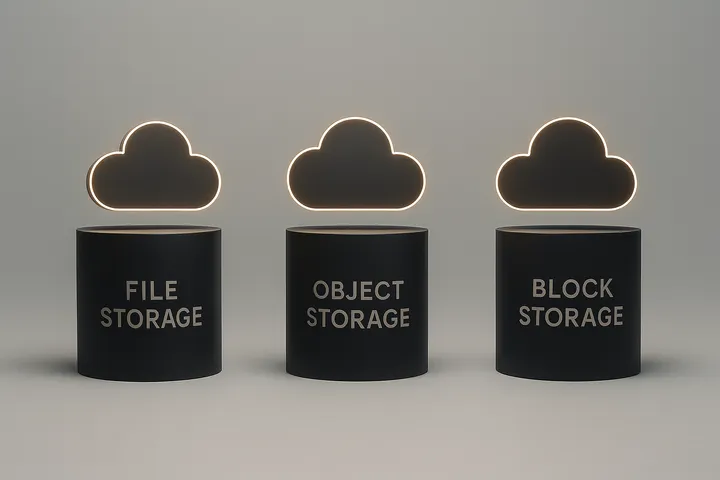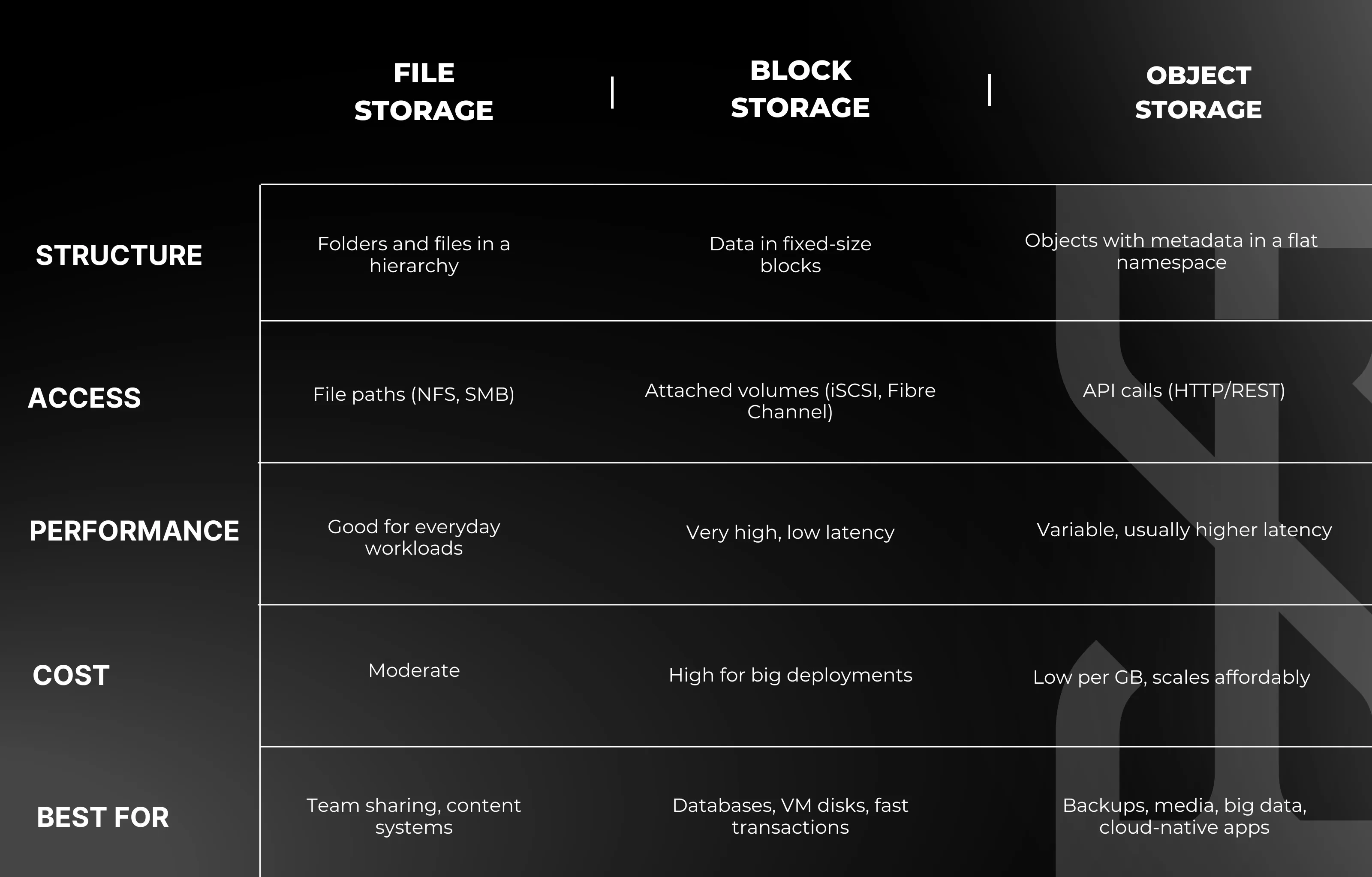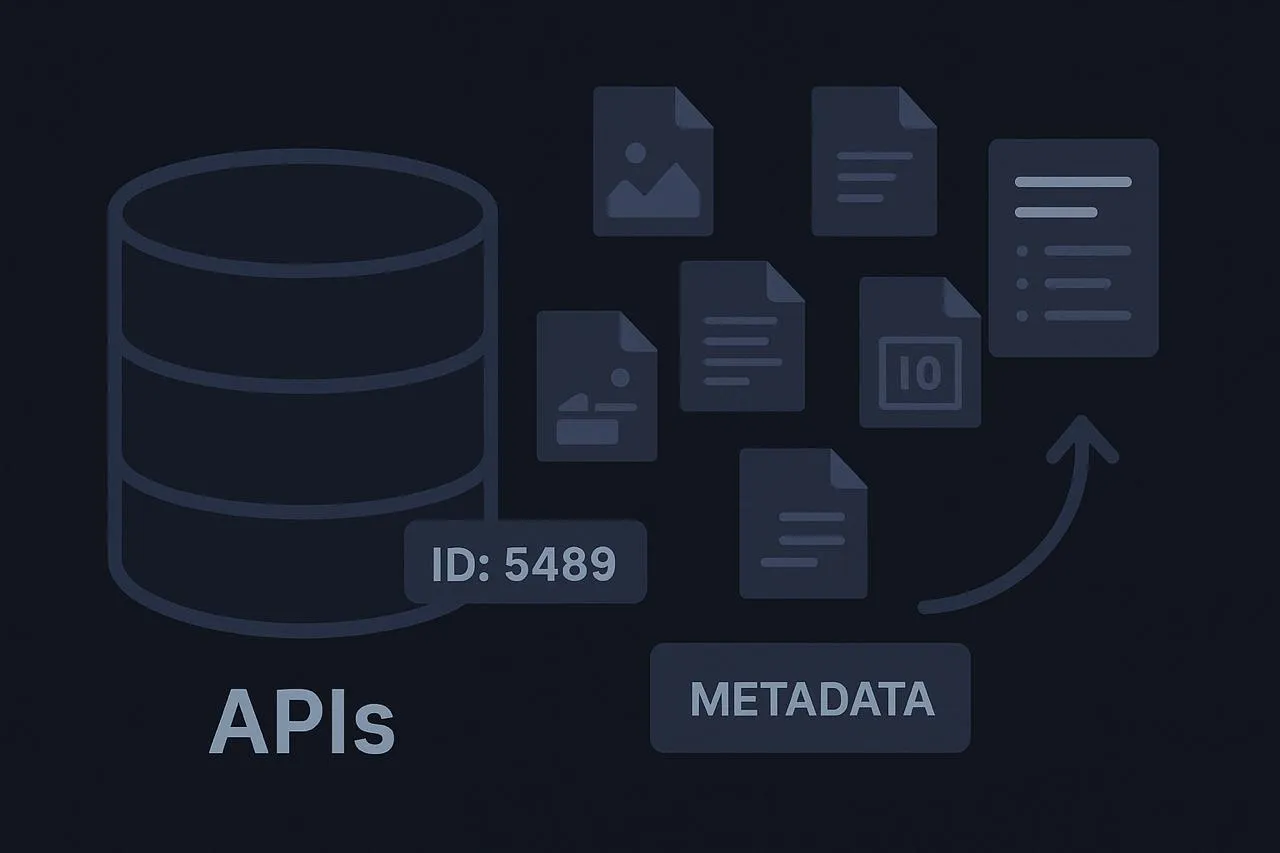Object, block, and file storage explained: key differences and use cases

All men are created equal, Thomas Jefferson famously said. But when it comes to storing data, not all storage is created equal. In this article, we will explain the three main types: object storage, block storage, and file storage, and what is best for you and your organisation.
European organisations deal with a variety of information: Structured and unstructured, small files and massive datasets, transactional databases and media archives. The type of storage you choose directly affects performance, scalability, cost and flexibility, and although these terms are sometimes used interchangeably in casual conversations, each represents a distinct way of organising, managing, and accessing data.
For example, high-performance workloads such as databases and virtual machines demand fast, low-latency block storage. Unstructured datasets like backups or IoT logs, however, are often far better suited to object storage, which can scale to petabytes at a relatively low cost.
SpaceTime optimises your storage for performance, security, cost and makes sure your infrastructure supports your growth instead of slowing it down.
Our core principle is to “bring your data home”. Put simply, that means we will store your data on European soil, closer to your operations and in compliance with EU data laws. Our pricing is simple because we dislike nothing more than complex cloud pricing and management systems.
So, let’s break down in plain language the big three (pun intended) storage types: object storage, block storage, and file storage and compare them.
What is file storage?
File storage is a term you probably know, but it is the right place to start since it is the most traditional and familiar approach to organising data. That means folders and files. Paths you can click through. It uses a hierarchical structure of directories and files, similar to the way your personal computer’s hard drive works. Each file has a name and a defined path, and users or applications access it by navigating through folders.
File storage may work for you as a consumer but we see its limitations when organisations start to deal with truly large-scale data. Performance slows as the number of files grows, and scaling a file system beyond certain thresholds can require complex architectures. Metadata in traditional file systems is typically minimal and often limited to information such as filename, size, and timestamps.Searching across millions of files can feel like finding a single sock in an industrial-sized dryer. Not fun or easy.
File storage shines when things are simple
It’s easy to set up, easy to use, and easy to share. It’s good when:
- Teams need to share and edit files together. Documents, images, videos so everyone can find what they need fast.
- Running content management systems. Websites, media libraries, or internal portals work smoothly with a file-based approach.
- Home directories or office NAS setups keep things organised. Staff can save their work in familiar folders without learning anything new.
- Workloads aren’t massive. If you’re not storing billions of files, performance stays solid.

What is object storage?
Object storage is the cloud’s favorite way to hold data. No folders. No hierarchy. Just objects. Each one has the data itself, a pile of metadata, and a unique ID. It digs through directories. You ask for what you need via APIs, usually over HTTP or REST. It’s like a giant, organised bucket (hence their name: S3 buckets) that never overflows.
The big reason companies love object storage is because it technically scales forever. But with hyperscalers like AWS, Google or Microsoft, storage costs can rise quickly. As your data explodes, you often pay not just for the storage itself but also for egress fees, API calls, and retrieval costs. Those pesky fees can add up fast.
At SpaceTime, we make scaling your object storage predictable and affordable, meaning that you only pay for space when and where you actually need it. We keep your hot data fast, your cold data cheap, and your growth headache‑free.
Object storage shines when scale is the priority
It’s cost‑effective, flexible, and ideal when:
- You’re storing mountains of unstructured data. Videos, photos, and logs that don’t fit neatly into folders.
- Backups and disaster recovery are critical. SpaceTime makes sure that your critical data is backed up and immutable. It’s a safety net in today’s ransomware-inflated world.
- Big data, analytics, and AI pipelines need fuel. Object storage feeds those engines without breaking the budget.
What is block storage?
Block storage is like owning a race car as a middle-aged family man: It’s thrilling when it’s moving fast, but maintenance takes time and money. Block storage doesn’t store files but instead it chops data into fixed‑size blocks. Each block gets an address, and the operating system stitches them together to look like a normal drive.
If you run apps or servers, block storage feels lightning‑fast and that’s why it is the favorite for workloads where delays are a deal‑breaker. However, scaling block storage can get pricey, especially as data grows.
Managing it isn’t always fun either: you have to set up, format, and watch over those volumes like a hawk. And because it doesn’t include metadata, you can’t easily tag or search data. It’s not really convenience but pure speed (Therefore, race car).
Block storage shines when performance is the priority
It’s a go‑to when:
- Databases need to run without lag. High‑speed reads and writes keep things smooth
- Virtual machines demand reliability. Block volumes act like dependable hard drives
- Transactional systems can’t afford slowdowns. Every millisecond counts in the middle of a big operation
- Critical apps need consistent performance. No room for downtime
Here's a comparison table listing the features between the storage types:

Which one should you choose?
When it comes to choosing object, block, or file storage, the short answer is that it depends.
Most businesses end up using all three. They’ll keep their core databases on block storage for performance, use object storage for media and backups, and rely on file storage for team collaboration.
If your team just needs to share and manage documents, file storage is often enough. It’s simple and user-friendly. If your systems run on critical apps like databases, block storage is the way to go. It delivers the speed and reliability you need. If you’re handling terabytes of unstructured data (videos, backups, logs, analytics) object storage wins on scalability and cost.
Here at SpaceTime, our mission is to make storage simple. We want to eliminate the common pain points of hyperscaler storage: hidden fees, unpredictable scaling costs, and complex management.
We help you focus on using your data, not fighting the storage systems Whether it’s for backups, analytics, content delivery, or high‑performance applications, everything works together securely, predictably, and at scale.




